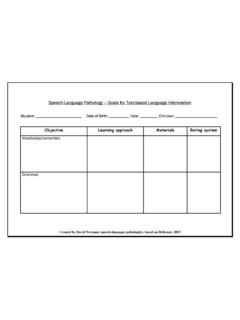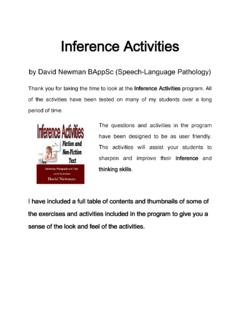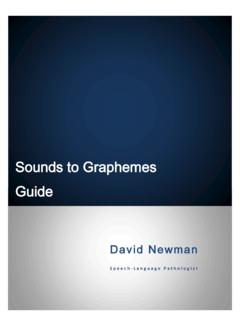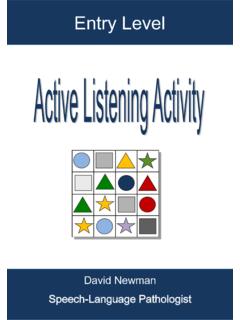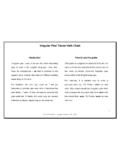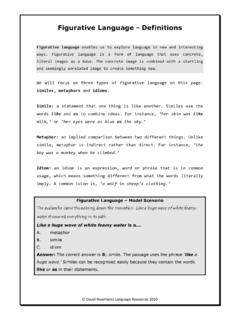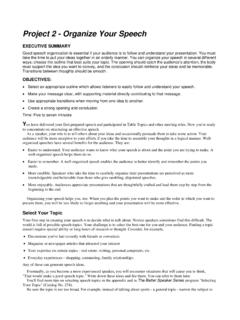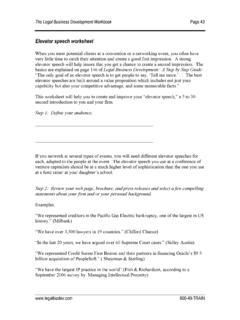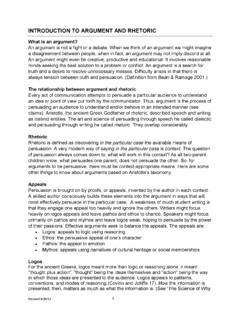Transcription of The Lateral Lisp - Speech-Language Resources
1 The Lateral Lisp David Newman speech Language Pathologist A Friendly Reminder David Newmonic Language Games 2013 - 2016. This book and all its contents are intellectual property. No part of this publication may be stored in a retrieval system, transmitted or reproduced in any way, including but not limited to digital copying and printing without the prior agreement and written permission of the author. All illustrations by David Newman 2. Created by David Newman Speech-Language Pathologist The Lateral lisp The Lateral lisp has perhaps bedevilled more speech pathologists than any other commonly occurring speech sound error. The Lateral lisp is arguably the most difficult sound error for children to get right despite speech pathologists' best intentions and hours of fruitless intervention.
2 What is a Lateral lisp? Similar to other types of lisps, the Lateral lisp affects the /s/ and /z/ speech sounds. A. Lateral lisp is a speech error where the airstream for the /s/ sound that is normally directed through the centre of the oral cavity over the midline of the tongue is instead thrust down laterally around the sides of the tongue. So instead of a lovely, sibilant, hissing /s/ the child produces an unattractive windy, slushy noise where the sound swirls out of the sides of the mouth rather than direct through the centre of the mouth. The mouth structure that the child adopts for the Lateral /s/ is considerably different from the mouth structure that produces a normal /s/ sound.
3 A typical /s/ is produced when the Lateral edges of the tongue lightly touch the upper teeth. This constructs a valley down the centre of the tongue. The airstream is guided through the narrow compression created by the tongue, producing a clear /s/ sound. The mouth construction for the Lateral lisp is somewhat different. The most prominent variations are that the tongue tip touches the alveolar ridge and the lips are drawn back wide. The jaw is retracted posteriorly. All of these structural changes alter the oral cavity, directing the airstream down and around the sides of the tongue and out of the sides of the mouth. 3. Created by David Newman Speech-Language Pathologist Lateral lisp experiment A quick experiment you may try is to shape your own mouth for the Lateral /s/.
4 To do this position your tongue tip firm against the alveolar ridge. Next, try to produce a normal /s/ sound without moving the tongue tip from the alveolar ridge. Do that now. What did you notice? You probably can't produce a normal /s/! During the experiment you may have noticed that the tongue automatically redirects the airstream. To produce the Lateral /s/ sound, which is essentially a variation of the normal /s/ sound, you must direct the air past the obstruction of the tongue tip against the alveolar ridge. The only route for the airstream is down and around the sides of the tongue. Note also how your mouth accommodates this new and novel airflow by stretching wider to allow the air to flow out of the sides of the mouth.
5 This fairly crude experiment should give some insight into what a child is doing to produce the Lateral /s/. Lateral lisp Intervention Bite Block The Lateral lisp can be corrected, but it does require some initial preparation. A child is taught the correct tongue placement and mouth structure with the initial use of a bite-block. A bite-block, also known as a mouth-prop wedge, can be purchased from any dental supplier. An alternative to a bite-block is for the child to use his or her own thumb, preferably sanitized. 4. Created by David Newman Speech-Language Pathologist The child is instructed to position the bite-block, or thumb, in the corner of the mouth.
6 (It doesn't matter if it's the left or right side of the mouth, so long as it's comfortable). Model the correct placement by using your own thumb as a bite-block in your own mouth, the child then positions his/her thumb in his or her mouth. The advantage of using a bite block is that it prevents the jaw from moving during intervention and makes it a relatively stable structure. Recall the experiment where you produced the Lateral /s/ - your jaw retracted and your mouth cavity broadened. A stabilized jaw helps to prevent this movement. Model the bite-block with your thumb The bite-block prevents the child from moving his or her jaw during intervention and enables the tongue to move autonomously without being shackled to jaw movement.
7 This gives the clinician a distinct advantage when teaching correct tongue position for the target /s/ sound. Lateral lisp Intervention /t/ sound The next step, once the jaw has been stabilized with a bite block, is for the child to produce an aspirated /t/. The /t/ sound is produced by placing the tongue tip against the alveolar ridge which is followed by an explosive release as the tongue is lowered and the air is released in a puff. Explain to the child that the /t/ is a plosive sound and 5. Created by David Newman Speech-Language Pathologist that our goal is to learn the /t/ sound and, later, its cousin the /ts/ sound. Do not mention the /s/ sound at this stage.
8 Model the correct /t/ with your bite-block positioned in your own mouth. The child then copies your model, with the bite-block or thumb in his or her own mouth. Explain that the /t/ sound is made by contacting the alveolar ridge with the tongue tip followed by an explosive release as the tongue is lowered. Once the child is able to consistently produce a nice, clear /t/, move onto teaching the child the /ts/ sound combination. Lateral lisp Intervention ts Explain to the child that the /ts/ is not a real sound but is in fact the name of a strange creature that will only answer to its name said correctly, so we need to say the name correctly. The creature's name is t.
9 Note that the target sound is the /s/. tacked onto the /t/ sound. At no stage mention the /s/ sound as being the target or the sound we are working on, otherwise the child will automatically revert to the Lateral /s/. The creature's name is disguised for those students who can read. Once again model the target sound with the bite-block or your thumb in your mouth. Produce a number of /t/ sounds rapidly t t t t t t t t. The child then copies your model. Model the rapid fire /t/ sounds but now elongate the last sound this will happily be the /s/ sound, t t t t t t ssssssss. The child again copies your model. The /s/ sound is produced automatically in this model because the jaw is stable, the tongue is released from the alveolar ridge and the airflow is flowing over the midline of the tongue.
10 At this stage the child should have no awareness that he or she has produced the correct /s/ sound which is part of our goal at this stage. 6. Created by David Newman Speech-Language Pathologist Lateral lisp Intervention call the t creature Once the child is able to produce a consistent /ts/ with the bite-block, try this activity. It's a useful method of practising the new sound while it is still relatively unstable. The child has to call the t (/ts/). The t is very shy and only responds to the right sound. We want to lure the t out of his cave. Once again place the bite-block in your mouth and model the sequence below. Position character pieces in front of child when needed.

